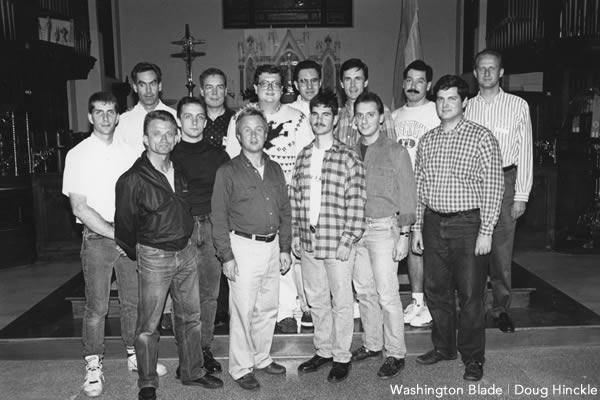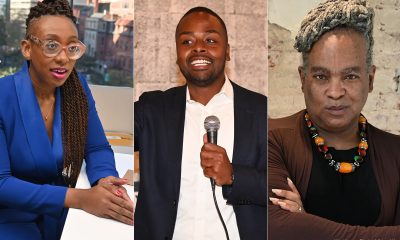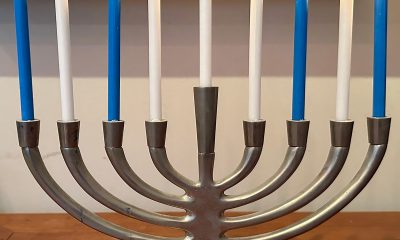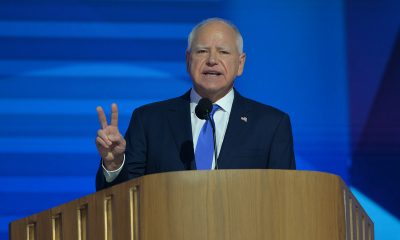Arts & Entertainment
Faith of our fathers
40-year-old gay Catholic group defies Vatican yet seeks communion
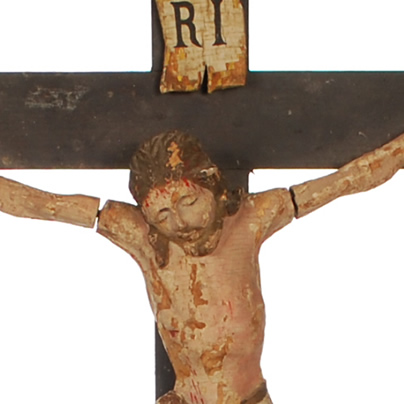
All the mainline Christian denominations by now have gay subgroups that have formed and many in the U.S. — Episcopalians, United Methodists and others — can point to huge strides they’ve made over the last several decades in persuading their hierarchies to acknowledge their presence.
Dignity/Washington, the largest chapter of the LGBT Roman Catholic group DignityUSA, has made so little progress making Vatican teaching less gay-condemning, the group, in many ways, has moved on to other goals it considers more realistic and achievable. The lone victories its members can count on that front are being invited indoors for a 1978 rainstorm during a weekend-long prayer vigil they held at the National Conference of Catholic Bishops at its former headquarters on Massachusetts Avenue (it didn’t foster a long-term dialogue) and a wave from current Pope Benedict XVI (Joseph Ratzinger) in the summer of 2010 (accompanying soon-to-be Cardinal Donald Wuerl did not follow suit).
If anything, the Vatican has become more anti-gay over the years. Though several regional parishes had long allowed Dignity groups to meet on their property, in 1986 Ratzinger, writing as the Vatican’s official keeper of church morality, issued a letter stating that gays and lesbians are “intrinsically disordered” and that gay organizations were no longer allowed the use of church property. It’s only gotten worse in recent years — in January, Pope Benedict condemned same-sex marriage efforts and called gay marriage, in an ironic choice of words, a threat “to human dignity and the future of humanity itself … pride of place goes to the family based on the marriage of a man and woman.”
And it wasn’t just talk — the Roman Catholic Church gave $2 million this year to unsuccessful efforts to outlaw same-sex marriage with November’s ballot initiatives in Maine, Maryland, Minnesota and Washington state, according to the Human Rights Campaign. As pro-LGBT efforts of any kind have taken root elsewhere, the Vatican has increasingly dug in its heels. Official church teaching is that although gays should “be accepted with respect, compassion and sensitivity,” “homosexual acts are intrinsically disordered” and “sexual activity only exists for the purpose of procreation.”
DignityUSA, however, has persevered. The Washington chapter, formed in the fall of 1972 (three years after the national group) and one of 45 active U.S. chapters, has its 40th anniversary events (“Forty and Fabulous on the First”) this weekend. On Saturday evening, a reception and dinner will be held at Clyde’s Restaurant (707 7th St., N.W.) with gay actor/singer Will Gartshore providing entertainment. On Sunday, Sr. Jeannine Gramick (Sisters of Loretto) will give the homily at a special “anniversary Mass.” The group meets weekly for a 6 p.m. Mass at St. Margaret’s Church, an Episcopal parish at 1820 Connecticut Ave., N.W. Details are at dignitywashington.org.
The sheer numbers are daunting. The Roman Catholic Church is the world’s largest Christian church with more than a billion members worldwide. It claims it is the one true church founded by Jesus Christ, that its bishops are the successors of Christ’s apostles and Pope Benedict is the successor to the biblical figure Peter. Though there was no recognized papacy until later centuries, Rome has named an unbroken line of bishops that dates to Peter and the first century. The Archdiocese of Washington did not respond to a request for comment for this article. Dignity/Washington members say relations with it are prickly at best.
“There’s no sense that the local archdiocese has evolved at all,” says Tom Bower, a gay member for almost the whole time the D.C. group has existed, a board member for eight years and co-chair for the anniversary committee. “They absolutely find us quite beyond the pale.”
DignityUSA, a U.S. group as its name implies (similar but unaffiliated gay Catholic groups exist in other countries), has about 6,000 dues-paying members, according to Executive Director Marianne Duddy-Burke, a lesbian, and an operating budget at the national level of about $550,000 though the chapters have their own budgets.
It’s a big weekend for the organization — the Boston chapter is also celebrating its 40th anniversary. San Diego, Chicago and New York also formed chapters in 1972. Dignity/Washington started with a group of about 20 at its first Mass. It moved from twice-monthly to weekly Mass in 1976. Membership and Mass attendance peaked at about 500 and 350 respectively in the late ‘80s. By late 1990, it had become the largest Dignity chapter in the U.S., a feat it maintains to this day, though membership is now about 200 with an average of 90-100 believers attending weekly Dignity Mass in D.C.
It owns its own building in Eastern Market that houses offices and provides space to other LGBT organizations such as Brother Help Thyself and Imperial Court. As with most Dignity chapters, Dignity/Washington prefers to let other churches host its services rather than build its own sanctuary.
“Most of our chapters are kind of hand to mouth,” Duddy-Burke says. “We pay our rent and our basic expenses, we have the weekly bulletins and we underwrite memberships for low-income people and most of our chapters give back to their own communities in some way. … Our model really isn’t based on the institutional model. We focus on the church as more of a community than a building.”
Despite the daunting odds, the group is celebrating. Bower says the group’s mere survival is a reason to be ecstatic.
“The official church would very much like us to disappear,” he says. “We show that you can be gay and Catholic at the same time and happily so and despite the major efforts of a much bigger organization to throw us out. We’re part of a national organization and when the Pope comes out against something gay, we’re able to say, ‘No, that’s wrong.’”
Bob Miailovich, a member for 35 years — someone left a Dignity brochure on his car while he was in a gay bar — agrees.
“This small group of gay men got together back in the early ‘70s — who would have ever envisioned this thing being as big as it is and the ongoing evolution of this group. I mean we’re a small group of sort of churchy guys, but it’s really opened up and I think we’re more broadly attuned to the world at this time and to what faith is all about.”
Despite the political and spiritual cold shoulder, DignityUSA wants to be recognized by the Holy See, the Roman Catholic Church’s central governing body. It’s a key component to the organization’s mission. While many LGBT Christian groups, Catholic and otherwise, have started their own denominations with no interest whatsoever in swaying the Vatican, Dignity, at its very core, feels that it’s important to stay within the church and fight as much as possible. Though many gay Christians cannot fathom wanting anything to do with the Roman Catholic Church after centuries of anti-gay teaching, Dignity members say it’s essential.
“People think, ‘Oh, why do you keep banging your head against the wall?’” Bower says. “That’s why we call it faith. It’s a belief that there is within the larger view of what it means to be Catholic, there’s something there that you just don’t have with other groups.”
Miailovich says despite the anti-gay teachings, he still “find(s) more truth in the Catholic Church than I do in other religions. It’s not perfect and I don’t buy everything at the end of the day but from what I know of other religions and what they teach and believe, I find more truth on the Catholic side than elsewhere else.”
As one might expect considering its size, millions have left the Catholic Church for all kinds of reasons and to varying degrees. Hard though it may be for LGBT people to fathom, there are even strains of Catholicism that have broken off from Rome because they feel the Vatican has gotten too liberal.
The most notorious is the Mexico City-based New Jerusalem, a gated community of about 3,000 that was founded in 1973 as a reaction to the Second Vatican Council of 1962-1965, a hugely influential change in Church teaching that allowed Masses to be said in languages besides Latin among many other things. Several “Traditionalist Catholic” splinter groups also revolted against Vatican II reform, but New Jerusalem is widely regarded as the most extreme — TV, radios, alcohol, makeup and pants for women are forbidden. Residents attend church three times daily, don’t recognize any post-Vatican II Roman church leaders and think Benedict is the anti-Christ. Fundamentalist splinter groups occur in other religions as well — the Fundamentalist Church of Jesus Christ of Latter-day Saints received massive media attention in recent years when its leader was convicted of two felony counts of child sexual assault.
Other groups have broken away on the opposite side of the theological spectrum. The North American Old Catholic Church considers itself a “2,000-year-old church with Apostolic succession” and teaches the “full inclusion of LGBT persons in our religious life, sacraments and clergy.” It also advocates for “the full inclusion of LGBT persons throughout society.” Two gay-welcoming Old Catholic churches were launched in Washington — one in 2011 and another this year— but appear to be inactive. Neither Presiding Bishop Rev. Michael Seneco, who’s gay, nor Rev. Kerolos Saleib of Saint Damien of Molokai Parish responded to multiple requests for comment or had recently updated websites. The churches that hosted them say they’re no longer meeting there. Salieb held a series of Masses at National City Christian Church during the International AIDS Conference this summer but fled the country soon after under mysterious circumstances. Duddy-Burke says many similar groups have come and gone over the years.
Denomination hopping between Episcopalians and Catholics, perhaps the two most stylistically similar denominations in the U.S., has been going on for all kinds of reasons for decades. Many progressive believers left the Catholic Church to find more gay- and women-friendly theology among Episcopalians, the Anglican Church in the U.S. The Catholic Church in recent years has started welcoming a spate of disenfranchised former Episcopalians who left disappointed that the church had become more gay-friendly. Others Episcopalians still, as has been widely reported, left their U.S. dioceses to align with more conservative Anglicans in other countries.
Bower says for him, converting to the Episcopal faith is not feasible.
“There are some basic theological differences between Catholicism and Episcopalianism,” he says. “Even in something as basic as Communion and the notion of transubstantiation. We really believe there is a change in the body and blood. They see it more as a memorial. And there’s a whole historical precedent of difference between the Roman and English churches.”
Others are pushing as far as they can under Vatican leadership and not just on LGBT issues. A lengthy article in the current edition of Rolling Stone magazine tells the stories of Sister Simone Campbell, Sister Margaret Farley and others who are “refusing to back down from the Catholic Church itself up to and including the Pope. On issues ranging from gay rights to abortion, the nuns are either openly contradicting church dogma or quietly undermining it with their silence, choosing instead to embrace a radical notion of missionary work that wouldn’t be out of place at an Occupy Wall Street rally: income inequality, universal health care, corporate responsibility, immigration reform,” and elsewhere reproductive rights. A group called Roman Catholic Womenpriests includes former nuns, ordains women as priests and holds women-led Masses.
Campbell, who didn’t immediately respond to a Blade interview request, told Rolling Stone, the same anti-LGBT beliefs are equally as harmful to women in the exclusively male-led Vatican.
“You’ve got to realize that any crowd that took 350 years to figure out Galileo might be right is not noted for rapid change,” she told Rolling Stone. “This is about a cultural clash between monarchy, in which the monarch is always right, and democracy where everybody has equal dignity, responsibility and opportunity, women and men. The whole idea that we live in a pluralistic society is news to these guys.”
The combined effect of all this shifting is a diminished Vatican hurt by a range of factors, from those turned off by its increasingly right-leaning teachings to millions lost and incalculable damage incurred by the clergy abuse scandals of recent years. Benedict, at times, has seemed almost cavalier about the loss, advocating for a “smaller, purer” church and saying that a church that seeks “above all to be attractive is already on the wrong path.”
Regardless of one’s political or religious views, the numbers are surprising — a third of those reared Catholic in the U.S. leave the church and, according to a Pew Research Study, 10 percent of all Americans are former Catholics. The losses have been partially offset by the disproportionately high number of immigrants who are Catholic.
Gramick, in a lengthy phone interview this week from her home in Mt. Ranier, Md., says the Roman Catholic “institution is unraveling.” Gramick, who declines to give her sexual orientation, was present at the first meeting to form Dignity/Washington in the cafeteria of the National Shrine of the Immaculate Conception with five others in 1971. She later formed New Ways Ministry, which she calls “a peace and justice center focused solely on the issue of lesbian and gay rights.”
Of the Church’s continual anti-gay teaching, she says it’s “causing a lot of dissonance and alienation among the Catholic community and a lot of Catholics out there in the pews, they’re no longer in the pews. Mass attendance has decreased dramatically in the last 20-30 years and actually what I think we’re seeing is the beginning of the dissolution of the institutional church. The institution is unraveling but the faith of the people is continuing and growing.”
Is it conceivable to imagine a post-Vatican world in another generation or two?
“If you’re talking erasure, I don’t think I’d go that far, but it’s unraveling certainly … it’s getting increasingly frayed and not only at the edges. It’s really closer to the center and it’s coming apart at the seams.”
Dignity Catholics don’t want that. At the most basic level, they believe the Vatican is simply wrong on the traditional view of Christian teaching and homosexuality, though opinions vary as to the reasons.
“We say basically go back and look at the theological arguments presented and they’re false,” Bower says. “We’re not picking and choosing which teachings to abide by. This is what you get when you look at the gospels. There really are no statements about LGBT people the way we think of it today. The type of homosexuality they were referring to was basically idol worship and temple prostitution.”
Having worked on these issues for decades, Gramick says the Vatican’s gay and lesbian theology is “not really based on the Bible.”
“It’s really more based on philosophy and natural law that uses scriptural quotes as backup,” she says. “It doesn’t really use scripture as the basis for its objection. They say homosexuality is unnatural without any acknowledgement that nature changes. What you see with the Vatican is an unwillingness to acknowledge change. If you have a 13th century mind, you would understand their position but with a 21st century mind and the science we’ve discovered, the human person is not what the Vatican thinks a person is. … Psychology has come so far since then. They didn’t know anything about Freud. When they come out with these views of it being a disorder, this is just not an enlightened view of psychology.”
Gramick’s iconoclastic work has not gone unnoticed — she says in the last 11 years, her religious community has received nine letters from the Vatican advising her superiors to have her dismissed from the Sisters of Loretto. The three presidents in that time have backed her, though the Church does play hardball — last month Rev. Roy Bourgeois was “canonically dismissed” for ordaining a woman at a Unitarian church in Kentucky in 2008.
Duddy-Burke says the decades of Vatican opposition have brought both a change of approach from DignityUSA and unexpected advantages.
“I think we’ve actually moved from trying to get acceptance from the Vatican to really leading the rest of the Church into being a more just Church,” she says. “I think we sort of feel like our job now is to hold our leadership accountable for the damage they’ve done and at the same time model a better way of living out the Gospel.”
She says slowly this approach has “caused people to see that the Church not only belongs to the Bishop and the Vatican. All of us who are baptized Catholics own the Church as well as the rites that are part of it. … If people ever caught on it would be like, ‘Wow, you’re governing it, you’re saying who preaches and presides, you decide if you want to use the new Roman Missel or not.’ Because we’ve been so excluded, we’ve had this opportunity to create the Church that we deserve and it’s an opportunity that a lot of Catholics haven’t had.”
Despite the Vatican’s refusal to bend, there’s growing evidence, both anecdotally and in serious research, that its official teachings are out of step with the majority of its laity — a summer poll conducted by the Pew Forum on Religion and Public Life found that 58 percent of Catholics favor same-sex marriage with 33 percent opposed. On matters as far-ranging as whether an unexcused absence from weekly Mass warrants a mortal sin to use of contraception, U.S. Catholics and many of their counterparts in other countries have long been a body of believers who haven’t felt they had to adhere to all church doctrine to stay in the church. Many parishes and clergy — even some who perform Dignity Masses — are quietly gay welcoming. They keep it low key to avoid interference from church leaders, but can sometimes be more welcoming than many would realize. So much so, in some cases, that it’s eaten into Dignity’s roster.
That’s partially why Dignity members say they don’t want to leave the church.
“The church really is the people of God,” Miailovich says. “It’s a horizontal assembly, not some vertical thing where you have the Pope at the top and an triangle going down with everyone else. Out there in the pews, there’s a great deal of support for a more progressive agenda, for women’s ordination, for married priests, you have the nuns on the bus for social justice. Everybody in the church does not believe 100 percent of everything that may be promulgated from on high.”
He also says there’s an “attitude that it’s my church and you can’t take it away from me.”
“I can’t leave what is mine and that leaves you with a sense that some day, somehow, change will be made. You’re right, there are people who’ve said, ‘Why spend a lifetime working with these people, let’s go start our own thing and not worry about what’s left behind.’ But I’m not going to change. This is who I am. This is how I pray and how I worship and here I am. We pray for our church leaders because we feel they need enlightenment.”
Bower agrees.
“We’ve found a peace and reconciliation within ourselves,” he says. “It’s more like a ‘We think we’re right and we’re here if you ever want to talk’-kind of thing. There’s less time today spent trying to articulate and debate all these issues because there’s really nobody to talk to on the other side.”
Despite, the ongoing dissent, Gramick says the occasion is a celebration.
“They’ve had a marvelous ministry here for 40 years ministering to local LGBT Catholics,” she says. “It’s really a time to rejoice.”
Books
Feminist fiction fans will love ‘Bog Queen’
A wonderful tale of druids, warriors, scheming kings, and a scientist
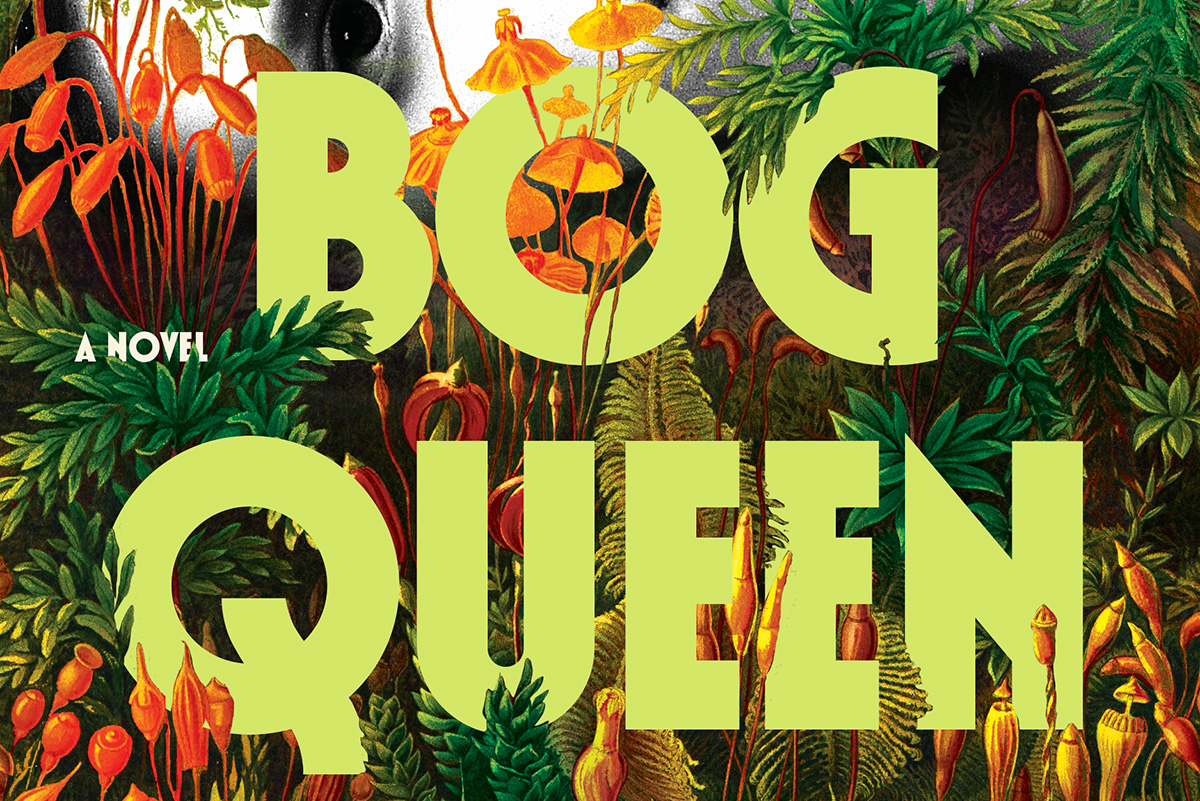
‘Bog Queen’
By Anna North
c.2025, Bloomsbury
$28.99/288 pages
Consider: lost and found.
The first one is miserable – whatever you need or want is gone, maybe for good. The second one can be joyful, a celebration of great relief and a reminder to look in the same spot next time you need that which you first lost. Loss hurts. But as in the new novel, “Bog Queen” by Anna North, discovery isn’t always without pain.

He’d always stuck to the story.
In 1961, or so he claimed, Isabel Navarro argued with her husband, as they had many times. At one point, she stalked out. Done. Gone, but there was always doubt – and now it seemed he’d been lying for decades: when peat cutters discovered the body of a young woman near his home in northwest England, Navarro finally admitted that he’d killed Isabel and dumped her corpse into a bog.
Officials prepared to charge him.
But again, that doubt. The body, as forensic anthropologist Agnes Lundstrom discovered rather quickly, was not that of Isabel. This bog woman had nearly healed wounds and her head showed old skull fractures. Her skin glowed yellow from decaying moss that her body had steeped in. No, the corpse in the bog was not from a half-century ago.
She was roughly 2,000 years old.
But who was the woman from the bog? Knowing more about her would’ve been a nice distraction for Agnes; she’d left America to move to England, left her father and a man she might have loved once, with the hope that her life could be different. She disliked solitude but she felt awkward around people, including the environmental activists, politicians, and others surrounding the discovery of the Iron Age corpse.
Was the woman beloved? Agnes could tell that she’d obviously been well cared-for, and relatively healthy despite the injuries she’d sustained. If there were any artifacts left in the bog, Agnes would have the answers she wanted. If only Isabel’s family, the activists, and authorities could come together and grant her more time.
Fortunately, that’s what you get inside “Bog Queen”: time, spanning from the Iron Age and the story of a young, inexperienced druid who’s hoping to forge ties with a southern kingdom; to 2018, the year in which the modern portion of this book is set.
Yes, you get both.
Yes, you’ll devour them.
Taking parts of a true story, author Anna North spins a wonderful tale of druids, vengeful warriors, scheming kings, and a scientist who’s as much of a genius as she is a nerd. The tale of the two women swings back and forth between chapters and eras, mixed with female strength and twenty-first century concerns. Even better, these perfectly mixed parts are occasionally joined by a third entity that adds a delicious note of darkness, as if whatever happens can be erased in a moment.
Nah, don’t even think about resisting.
If you’re a fan of feminist fiction, science, or novels featuring kings, druids, and Celtic history, don’t wait. “Bog Queen” is your book. Look. You’ll be glad you found it.
Movies
A Shakespearean tragedy comes to life in exquisite ‘Hamnet’
Chloe Zhao’s devastating movie a touchstone for the ages

For every person who adores Shakespeare, there are probably a dozen more who wonder why.
We get it; his plays and poems, composed in a past when the predominant worldview was built around beliefs and ideologies that now feel as antiquated as the blend of poetry and prose in which he wrote them, can easily feel tied to social mores that are in direct opposition to our own, often reflecting the classist, sexist, and racist patriarchal dogma that continues to plague our world today. Why, then, should we still be so enthralled with him?
The answer to that question might be more eloquently expressed by Chloe Zhao’s “Hamnet” – now in wide release and already a winner in this year’s barely begun awards season – than through any explanation we could offer.
Adapted from the novel by Maggie O’Farrell (who co-wrote the screenplay with Zhao), it focuses its narrative on the relationship between Will Shakespeare (Paul Mescal) and his wife Agnes Hathaway (Jessie Buckley), who meet when the future playwright – working to pay off a debt for his abusive father – is still just a tutor helping the children of well-to-do families learn Latin. Enamored from afar at first sight, he woos his way into her life, and, convincing both of their families to approve the match (after she becomes pregnant with their first child), becomes her husband. More children follow – including Hamnet (Jacobi Jupe), a “surprise” twin boy to their second daughter – but, recognizing Will’s passion for writing and his frustration at being unable to follow it, Agnes encourages him to travel to London in order to immerse himself in his ambitions.
As the years go by, Agnes – aided by her mother-in-law (Emily Watson) and guided by the nature-centric pagan wisdom of her own deceased mother – raises the children while her husband, miles away, builds a successful career as the city’s most popular playwright. But when an outbreak of bubonic plague results in the death of 11-year-old Hamnet in Will’s absence, an emotional wedge is driven between them – especially when Agnes receives word that her husband’s latest play, titled “Hamlet,” an interchangeable equivalent to the name of their dead son, is about to debut on the London stage.
There is nothing, save the bare details of circumstance around the Shakespeare family, that can be called factual about the narrative told in “Hamnet.” Records of Shakespeare’s private life are sparse and short on context, largely limited to civic notations of fact – birth, marriage, and death announcements, legal documents, and other general records – that leave plenty of space in which to speculate about the personal nuance such mundane details might imply. What is known is that the Shakespeares lost their son, probably to plague, and that “Hamlet” – a play dominated by expressions of grief and existential musings about life and death – was written over the course of the next five years. Shakespearean scholars have filled in the blanks, and it’s hard to argue with their assumptions about the influence young Hamnet’s tragic death likely had over the creation of his father’s masterwork. What human being would not be haunted by such an event, and how could any artist could avoid channeling its impact into their work, not just for a time but for forever after?
In their screenplay, O’Farrell and Zhao imagine an Agnes Shakespeare (most records refer to her as “Anne” but her father’s will uses the name “Agnes”) who stands apart from the conventions of her town, born of a “wild woman” in the woods and raised in ancient traditions of mysticism and nature magic before being adopted into her well-off family, who presents a worthy match and an intellectual equal for the brilliantly passionate creator responsible for some of Western Civilization’s most enduring tales. They imagine a courtship that would have defied the customs of the time and a relationship that feels almost modern, grounded in a love and mutual respect that’s a far cry from most popular notions of what a 16th-century marriage might look like. More than that, they imagine that the devastating loss of a child – even in a time when the mortality rate for children was high – might create a rift between two parents who can only process their grief alone. And despite the fact that almost none of what O’Farrell and Zhao present to us can be seen, at best, as anything other than informed speculation, it all feels devastatingly true.
That’s the quality that “Hamnet” shares with the ever-popular Will Shakespeare; though it takes us into a past that feels as alien to us as if it took place upon a different planet, it evokes a connection to the simple experience of being human, which cuts through the differences in context. Just as the kings, heroes, and fools of Shakespeare’s plays express and embody the same emotional experiences that shape our own mundane modern lives, the film’s portrayal of these two real-life people torn apart by personal tragedy speaks directly to our own shared sense of loss – and it does so with an eloquence that, like Shakespeare’s, emerges from the story to make it feel as palpable as if their grief was our own.
Yes, the writing and direction – each bringing a powerfully feminine “voice” to the story – are key to the emotional impact of “Hamnet,” but it’s the performances of its stars that carry it to us. Mescal, once more proving himself a master at embodying the kind of vulnerable masculine tenderness that’s capable of melting our hearts, gives us an accessible Shakespeare, driven perhaps by a spark of genius yet deeply grounded in the tangible humanity that underscores the “everyman” sensibility that informs the man’s plays. But it’s Buckley’s movie, by a wide margin, and her bold, fierce, and deeply affecting performance gives voice to a powerful grief, a cry against the injustice and cruelty of what we fumblingly call “fate” that resonates deep within us and carries our own grief, over losses we’ve had and losses we know are yet to come, along with her on the journey to catharsis.
That’s the word – “catharsis” – that defines why Shakespeare (and by extension, “Hamnet”) still holds such power over the imagination of our human race all these centuries later. The circumstantial details of his stories, wrapped up in ancient ideologies that still haunt our cultural imagination, fall away in the face of the raw expression of humanity to which his characters give voice. When Hamlet asks “to be or not to be?,” he is not an old-world Danish Prince contemplating revenge against a traitor who murdered his father; he is Shakespeare himself, pondering the essential mystery of life and death, and he is us, too.
Likewise, the Agnes Shakespeare of “Hamnet” (masterfully enacted by Buckley) embodies all our own sorrows – past and future, real and imagined – and connects them to the well of human emotion from which we all must drink; it’s more powerful than we expect, and more cleansing than we imagine, and it makes Zhao’s exquisitely devastating movie into a touchstone for the ages.
We can’t presume to speak for Shakespeare, but we are pretty sure he would be pleased.

Friday, January 9
Women in Their Twenties and Thirties will be at 8 p.m. on Zoom. This is a social discussion group for queer women in the Washington, D.C. area. For more details, visit Facebook.
“Backbone Comedy” will be at 8 p.m. at As You Are. Backbone Comedy is a queer-run fundraiser comedy show at As You Are Bar DC, where comics stand up for a cause. Each show, a percentage of proceeds go to a local organization – Free Minds DC, a reentry organization for individuals impacted by incarceration. Tickets cost $19.98 and are available on Eventbrite.
Saturday, January 10
Go Gay DC will host “LGBTQ+ Community Brunch” at 11 a.m. at Freddie’s Beach Bar & Restaurant. This fun weekly event brings the DMV area LGBTQ+ community, including allies, together for delicious food and conversation. Attendance is free and more details are available on Eventbrite.
Monday, January 12
“Center Aging: Monday Coffee Klatch” will be at 10 a.m. on Zoom. This is a social hour for older LGBTQ+ adults. Guests are encouraged to bring a beverage of choice. For more information, contact Adam ([email protected]).
Genderqueer DC will be at 7 p.m. on Zoom. This is a support group for people who identify outside of the gender binary, whether you’re bigender, agender, genderfluid, or just know that you’re not 100% cis. For more details, visit genderqueerdc.org or Facebook.
Tuesday, January 13
Coming Out Discussion Group will be at 7 p.m. on Zoom. This is a safe space to share experiences about coming out and discuss topics as it relates to doing so — by sharing struggles and victories the group allows those newly coming out and who have been out for a while to learn from others. For more details, visit the group’s Facebook.
Trans Discussion Group will be at 7 p.m. on Zoom. This group is intended to provide an emotionally and physically safe space for trans people and those who may be questioning their gender identity/expression to join together in community and learn from one another. For more details, email [email protected].
Wednesday, January 14
Job Club will be at 6 p.m. on Zoom upon request. This is a weekly job support program to help job entrants and seekers, including the long-term unemployed, improve self-confidence, motivation, resilience and productivity for effective job searches and networking — allowing participants to move away from being merely “applicants” toward being “candidates.” For more information, email [email protected] or visit thedccenter.org/careers.
The DC Center for the LGBT Community will partner with House of Ruth to host “Art & Conversation” at 3 p.m. at 1827 Wiltberger St., N.W. This free workshop will involve two hours of art making, conversation, and community. Guests will explore elements of healthy relationships with a community-centered art activity. This workshop involves paint, so please dress accordingly. All materials will be provided. For more details, email [email protected].
Thursday, January 15
The DC Center’s Fresh Produce Program will be held all day at the DC Center for the LGBT Community. People will be informed on Wednesday at 5 p.m. if they are picked to receive a produce box. No proof of residency or income is required. For more information, email [email protected] or call 202-682-2245.
Virtual Yoga Class will be at 7 p.m. on Zoom. This free weekly class is a combination of yoga, breathwork and meditation that allows LGBTQ+ community members to continue their healing journey with somatic and mindfulness practices. For more details, visit the DC Center’s website.


